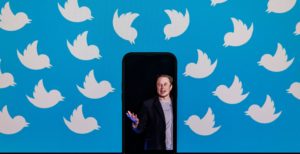“How can a man in a cave out-communicate the world’s leading communications society?” wondered Richard Holbrooke, the dean of the American Diplomatic Corps, in the aftermath of 9/11. What startled Holbrooke, and presumably many of the readers of his Washington Post editorial, wasn’t Osama bin Laden’s terror attacks themselves but rather the Al Qaeda chief’s ability to control the framing of those attacks without a state or a television station of his own. To answer this new threat, Holbrooke called for a centralised authority run by the White House that would combine the powers of the State Department, the Pentagon, the Justice Department, the CIA and other government agencies in order to impose America’s preferred interpretation of reality upon the world.
Over two decades later, the flaws in Holbrooke’s grandiose plan for a global propaganda war directed from Washington are glaringly obvious. At the heart of Holbrooke’s conception of what became known as the Global War on Terror (GWOT) was the idea that the crucial post-9/11 battles would be won or lost not in physical locations in Afghanistan and Iraq but rather inside the heads of ordinary Muslims. The truth was that bin Laden and his terrorists understood their target audience far better than the White House, the CIA and the FBI ever could or did. Yet bizarrely, the dream of controlling reality through semiotic and technical means remains current in Washington and other Western capitals, even as the battlefields of the Middle East have gone silent. What started out as a way to fight a far-away foe has quietly metastasised into a totalitarian fantasy of endless warfare against the erroneous thoughts and feelings of ordinary citizens closer to home.
The idea of “information warfare” was born in the Seventies, when Pentagon war colleges began to take notice of the role played by so-called information operations in Soviet military planning, particularly in promoting third-world insurgencies. In 1991, American military planners included a heavy “information operations” (IO) component in the first Gulf War, which, despite featuring large set-piece tank battles in the desert, was widely labelled “the first information war”. In American military doctrine, IO was defined as a toolbox of capabilities consisting of computer network operations, electronic warfare, operational security, psychological operations, and deception. It was these capabilities, merged with high-flown Cold War rhetoric about freedom and democracy, that Holbrooke, President George W. Bush and others imagined would ultimately win the war against Al Qaeda.
America’s withdrawal of its military forces from Iraq and Afghanistan under Barack Obama left many with a less optimistic view of US IO capabilities. “Many analysts have concluded that the new media conditions are tilted in favour of non-state actors, such as insurgent militias or terrorist groups,” wrote Amy Zalman, an expert who frequently consulted for the Pentagon. “When information is restricted, the remaining void is quickly filled with conspiracy theories and distorted facts. These theories balloon and proliferate with startling speed, because it is so cheap and easy for most of us to access the means of digital communication.”
Yet the failure of the American war in Iraq, launched 20 years ago this month, and the seeming futility of IO efforts when confronted with the ungovernable spaces opened up by the internet and mobile phones, only seemed to strengthen the Pentagon’s underlying belief in the fusion of information operations (IO) and counter-terror (CT) tactics as the future of modern warfare. “In cognitive warfare, the human mind becomes the battlefield,” summarised an article in The Nato Review in May 2021. “The aim is to change not only what people think, but how they think and act. Waged successfully, it shapes and influences individual and group beliefs and behaviours to favour an aggressor’s tactical or strategic objectives. In its extreme form, it has the potential to fracture and fragment an entire society, so that it no longer has the collective will to resist an adversary’s intentions.”
A key turning point in transforming these tactics from a war-fighting technique to a new theory of Western governance happened quietly a decade ago, when large-scale spying on US citizens by the NSA was licensed by the Obama White House. Documents leaked in 2013 by Edward Snowden alerted the public to a series of domestic spying programmes, as well as the fact that the NSA was routinely mining social media platforms to build profiles on Americans without judicial review. While the NSA had previously been required to stop searching the contact chain of a foreign target when it reached a US citizen, a change in policy allowed intelligence services to continue tracing the online contacts of Americans so long as there was a “foreign intelligence” purpose to justify the snooping.
In the wake of the Snowden revelations, hints of further centralised US government surveillance activities using private technology companies began to emerge. The Obama administration routinely spied on reporters by monitoring their private telephone records and using that information to issue subpoenas to force them to reveal their sources. In 2014, Twitter filed a suit against the US Department of Justice and the FBI, stating that it had been served FISA (Foreign Intelligence Surveillance Act) warrants to collect the electronic communications of its users. Some of these efforts were apparently focused on the Obama administration’s attempts to sell the Iran Deal, the centrepiece of his second term.
Twitter’s lawsuit, which asked the court for permission to release a public report containing the precise number of warrants it had been served, was filed by Perkins Coie, the prominent Democratic Party-aligned DC law firm. The firm’s lead attorney in the case was a former DOJ cybersecurity expert named Michael Sussmann. Then-FBI General Counsel James Baker, who was friends with Sussman, refused Twitter’s request. Crucially, the entire cast of characters involved — including Obama, Twitter, the FBI, Perkins Coie, James Baker and Michael Sussman — would soon play important roles in a startling expansion of the US government’s nascent efforts to wage information warfare against its own citizens.
The device by which this transformation was effectuated was the so-called Russiagate conspiracy theory, which falsely claimed that Donald Trump had been handed the White House by agents of Vladimir Putin. Even if the evidence for Russiagate was often only legible to true believers on social media, who often sounded like characters in a Philip K. Dick novel, its function in Washington was entirely practical. By identifying Trump as an extension of Putin, the Russiagate theory neatly transformed a foreign threat into a domestic one — thereby legitimising all-out warfare by the Washington establishment against a President that many believed to be a dangerous lunatic.
Russiagate began when Perkins Coie, then employed by Democratic Presidential candidate Hillary Clinton, paid a company called Fusion GPS, run by an ex-journalist named Glenn Simpson, to produce a dossier of dubious reports under the by-line of a British ex-spy named Christopher Steele. Before leaving office, Obama ordered his spy chief John Brennan to draft an official assessment claiming that the Steele dossier was real — and that Putin had helped put Trump in the White House. Obama then signed into law the Countering Foreign Propaganda and Disinformation Act, targeting Putin, and by extension Trump.
If the Global War on Terror was founded on a profound misapprehension of America’s ability to control how other people interpret reality, Obama’s war on foreign propaganda and disinformation was founded on an outright lie that was kept alive for years by a pliant media addicted to taking handouts from nameless operatives who waged information warfare against their political enemies — and a majority of the country. “The Russian intervention was essentially a hijacking — of American companies like Facebook and Twitter,” a typical 2018 feature in The New York Times falsely asserted. The extent of the “massive fraud” that had occurred on social media platforms suggested a “plausible case that Mr Putin succeeded in delivering the presidency to his admirer, Mr Trump”. Yet according to exhaustive investigations by Robert Mueller and the US Department of Justice, the only fraud that occurred was the promotion by every normative authority and publication in the county of a hallucinatory conspiracy theory that allowed the DC establishment to bring the GWOT back home and use it an instrument to control the American public.
In the autumn of 2017, the FBI increased its leverage over the content of social media by establishing the Foreign Influence Task Force (FITF) “to identify and counteract malign foreign influence operations” through “strategic engagement with US technology companies”. The Department of Homeland Security set up the Cybersecurity and Infrastructure Security Agency (CISA) to serve a similar purpose. Together, these and similar nodes in other agencies helped knit together US intelligence agencies, Big Tech companies, civil society institutions, and major media organisations into a single warfare behemoth whose job it was to “secure” the US information environment. And since “Russia” equalled Trump, stopping “Russian disinformation” meant censoring Trump, his supporters, and anyone else opposed to the bureaucratic takeover of domestic communications infrastructure.
CISA’s censorship of Twitter, which is now a matter of public record, provides one example of how the new public-private information warfare partnerships worked. One such partnership was the Election Integrity Partnership (EIP), a censorship consortium consisting of the Stanford Internet Observatory, the University of Washington’s Center for an Informed Public, the Atlantic Council’s Digital Forensic Research Lab, and Graphika, a DC-based company made up of former national security officials and employed by the Senate Intelligence Committee. According to the recent Twitter files dump, CISA regularly censored information by filing requests with EIP, which relayed them to Twitter, Facebook, and other tech companies.
By this point, Twitter had given up suing the US government. In fact, James Baker, the former FBI chief counsel who had refused to allow Twitter to spill the beans on the US government’s use of its platform, and then authorised the FISA warrant that laid the basis for Russiagate, was now Twitter’s own in-house lawyer — one of at least a dozen former FBI and intelligence community operatives working to actively promote censorship policies based on a conspiracy theory that the platform’s own internal metrics showed was a lie.
In pressuring technology companies to do their bidding, the US security bureaucracy and its external allies in the Democratic Party and anti-Trump circles utilised two key levers of power. The first was the threat to regulate digital monopolies such as Google, Facebook and Twitter. The second was to label the technology companies that had supposedly been leveraged by Putin as national security threats. Both these tactics relied on the wording of Section 230 of the Communications Decency Act of 1996, a law originally intended to punish the distribution of child pornography, which exempted Google and Facebook from libel and other claims for which publishers of newspapers, magazines and other editorial products remained liable — on the theory that tech platforms were not publishers.
Monopoly platforms such as Google and Facebook were now caught in a bind. Facing potentially ruinous regulation, and at risk of being labelled national security threats, the platforms were prohibited from engaging in editorial decision-making that would turn their shiny liability-free monopolies into ordinary publishing pumpkins under the terms of Section 230 of the CDA. What the technology companies needed, in other words, was an external authority that would make editorial decisions for them, on a basis that would be acceptable to Democrats and national security bureaucrats.
Enter the fact-checkers. As a profession, fact-checking was once a minor ornament of the grand edifice of mid-20th-century American journalism. As that edifice collapsed in the face of competition from internet platforms, which hoovered up all their advertising dollars, fact-checkers began to replace actual journalists. Between 1990 and 2017, US newspapers lost more than a quarter of a million jobs, a decline of more than half. Meanwhile, between 2014 and June 2021, the number of fact-checking organisations in the US — employing mostly freelance workers with no particular qualifications or prior experience — rose from 44 to 341, an increase of nearly 800%, the vast bulk of that rise having been funded in order to support the false assertion that “foreign disinformation” had swung the 2016 election in favour of Trump.
On November 17, 2016, an organisation called the International Fact-Checking Network (IFCN) published an open letter to Facebook CEO Mark Zuckerberg, whose company’s acceptance of $150,000 in Russian-linked ads supposedly resulted in Trump’s victory. “We would be glad to engage with you about how your editors could spot and debunk fake claims,” the IFCN suggested on behalf of the 20 fact-checking organisations belonging to its network. The following month, Facebook announced that the IFCN would be its main partner in fact-checking all claims made on the world’s largest social media platform.
The IFCN was launched in 2015 as a division of the Poynter Institute, a media non-profit. Initial funders of the IFCN included the National Endowment for Democracy, the Omidyar Network, the Bill & Melinda Gates Foundation, and George Soros’s Open Society Foundations. The partisan nature of “fact-checking” activity provided by the IFCN and its partners and similar agglomerations was not hard to spot: analysis from 2018 of fact-checks by the Associated Press found that 94% were made on Republican and conservative statements. The new “fact-checking” system allowed the major internet platforms to keep their monopolies, at the price of binding them to the Democratic Party and the DC bureaucracy.
The pandemic only tightened the elite nexus between bureaucrats, the Democratic Party, and technology companies in the attempt to make information safe for Americans. In February 2020, for example, The Washington Post denounced Arkansas Senator Tom Cotton for promoting a “debunked” “conspiracy theory” that Covid-19 had escaped from a Chinese lab in Wuhan. In May 2020, the Post’s head “fact-checker”, Glenn Kessler, a member of the IFCN advisory board, said it was “virtually impossible” for the virus to have come from a laboratory. The head of the FBI, Cristopher Wray, has now acknowledged that scenario as likely. Heretical information on the failure of lockdowns in halting transmission of Covid and the regressive inefficiency of masking children in schools was treated the same way, skewing public opinion in favour of bureaucratically convenient falsehoods and radically decreasing public trust in doctors and public-health authorities.
In October of 2020, the new domestic information security complex showed its overt partisan political purpose by massively censoring news reports about the contents of the hard drive of a computer belonging to Hunter Biden while his father was running for the presidency. In addition to lurid footage of Hunter Biden smoking crack and having sex with prostitutes, the hard drive, which had turned up in a Delaware repair shop, contained politically-damning information about business dealings between the Biden family, including Joe Biden, and companies with ties to the governments and spy services of China and Ukraine. It was, in other words, a huge political story of the type that decides elections — except very few Americans saw it in time. When they did see it, they were told that the story was a fake, the likely product of a Russian disinformation campaign.
At Facebook, Andy Stone, once the Democratic Congressional Campaign Committee press secretary, explained that the reduction of Facebook’s “distribution” of the article would go into place while it was looked over by Facebook’s “third party fact checking partners”. Twitter’s CEO Jack Dorsey, and his top attorney, Vijaya Gadde, kept the article from being shared on their website on the grounds that the material potentially constituted an invasion of Hunter Biden’s privacy. Meanwhile, the Twitter files show that the FBI paid Twitter nearly $3.5 million for the platform’s work censoring “dangerous” content.
The FBI unit designated to coordinate with social media companies during the 2020 election was the Foreign Influence Task Force, which was led by agent Elvis Chan and corresponded with Twitter and other tech companies to identify alleged foreign influence and election tampering. Chan openly pushed the theory that the Hunter Biden laptop was a “Russian disinformation operation” — a theory underwritten by an open letter signed by no fewer than 50 distinguished US intelligence officials. Yet former head of site security Yoel Roth, himself an impeccable leftist, claimed to have found little evidence of Russian activity on Twitter. According to Roth, the FBI primed him to attribute reports about Hunter Biden’s laptop to a Russian hacking operation. Needless to say, the FBI’s reports — and subsequent “disinformation” claims — were disinformation invented by the FBI, which had been in possession of the laptop for nearly a year and therefore knew the material on the Bidens to be authentic.
Donald Trump may indeed be a dangerous lunatic, or simply a crackpot — but the attempt to “secure” the US information environment from his supposedly malign influence has proven to be far more destructive than anything Trump actually did as President. As our brains were turned into battlefields by political operatives and government bureaucrats, using their power over private companies to manipulate and censor information in the service of what they regarded to be publicly beneficial falsehoods, it is hardly surprising that public confidence in the American press has fallen to the lowest levels ever recorded. Only 16% of American adults in a recent Gallup poll expressed “a great deal” of confidence in the information they receive from newspapers, with 11% expressing similar levels of confidence in what they see on television. Among Republicans, the number expressing confidence in newspapers is 5%. This decline in confidence has no parallel in any other Western country. Americans, it turned out, were no more susceptible to domestic information operations than Muslims were in the Middle East two decades earlier.
Now America, just like Afghanistan and Iraq, must face the challenge of how to govern a country in which trust has been comprehensively shattered, and all that is left is a landscape of endless information operations run by warring tribes who define their opponents as “insurrectionists” and “terrorists”. None of these efforts to define reality seem likely to do much to promote social peace in the US, any more than they succeeded in bringing peace and democracy to the Middle East. Twenty years later, it would appear that bin Laden’s paradoxical understanding of asymmetric warfare was right: the most powerful weapon against the West is the West.
Disclaimer
Some of the posts we share are controversial and we do not necessarily agree with them in the whole extend. Sometimes we agree with the content or part of it but we do not agree with the narration or language. Nevertheless we find them somehow interesting, valuable and/or informative or we share them, because we strongly believe in freedom of speech, free press and journalism. We strongly encourage you to have a critical approach to all the content, do your own research and analysis to build your own opinion.
We would be glad to have your feedback.
Source: UnHerd Read the original article here: https://unherd.com/





